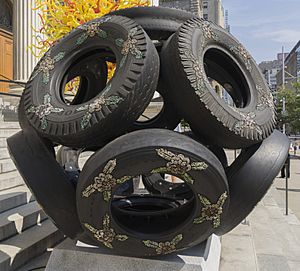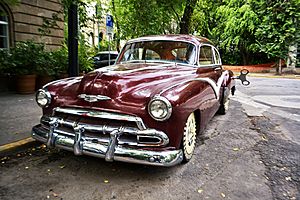Betsabeé Romero facts for kids
Quick facts for kids
Betsabeé Romero
|
|
|---|---|

Betsabeé Romero, 2016
|
|
| Born | 1963 (age 61–62) Mexico City, Mexico
|
| Alma mater | Universidad Iberoamericana |
| Known for | Visual artist, sculptor |
Betsabeé Romero, born in 1963, is a famous artist from Mexico. She creates amazing art using sculptures, installations, prints, and even videos. Her art has been shown all over the world, in over 40 special exhibitions just for her! You can find her work in places like the Americas, Africa, Asia, and Europe.
Romero calls herself a "mechanic artist." She uses everyday items like old tires, car parts, and even chewing gum. These materials are important because they show how much we use and throw away things in cities. She mixes these modern items with traditional Mexican symbols and ideas. This helps her think about history, culture, and the interesting mix of old and new.
Her art often talks about important social topics. These include people moving to new places, how boys and girls are expected to act, and different cultural traditions. She also explores religion and how different cultures mix. Her work is deeply connected to Mexico's history and traditions. But people all over the world can understand and connect with her art today.
Contents
Becoming an Artist
Betsabeé Romero was born in Mexico City in 1963. She went to the Universidad Iberoamericana from 1980 to 1984. There, she earned her first degree in Communication.
She then studied Fine Arts at the Academy of San Carlos in 1986. Romero also learned art in Paris, France, at the Louvre and the École nationale supérieure des Beaux-Arts. After her studies in France, she returned to Mexico. She wanted to learn more about ancient Mexican art and art from the colonial period. In 1994, she earned a second master's degree in Art History from Universidad Nacional Autónoma de México (UNAM).
Romero believes that culture is everywhere. She once said, "Culture exists where people write, sing, cook or dance." She thinks culture can cross borders and live on, even in a song or the smell of a dish.
What Her Art Is Made Of
Betsabeé Romero likes to use materials that have already been used and thrown away. Some of her favorite things to work with are old car tires and other car parts. She turns these everyday items into amazing art. She makes "refashioned cars, carved tires, painted hoods, and incised mirrors."
She adds images and symbols from Mexican history and culture to these items. These symbols can be from ancient times or from today. Tires and cars also represent movement and people traveling to new places.
Many of Romero's artworks mix sculpture and printmaking. She uses modern materials with traditional designs. For example, she carves patterns and symbols onto large, old tires. She treats the rubber like it's wood. Sometimes, she uses these carved tires like giant rollers to make prints on fabric or clay.
The materials she uses have a bigger meaning too. Natural rubber comes from a tree found in Brazil and other parts of South America. The history of rubber is very complex. It has affected societies, economies, and politics around the world. Romero has also used chewing gum in her art, like in her sculpture De Tuti fruti. Gum comes from a tree in southern Mexico. Its history goes back to the ancient Mayans and Aztecs.
Romeros art makes us think about how modern factories use natural things. They turn materials like clay, rubber, and gum into products for everyone.
Art Exhibitions
Betsabeé Romero has shown her art in over 20 biennials. These are big art shows that happen every two years. Some were in Cuba, Brazil, and Canada. She has also had more than 40 solo exhibitions. These are shows where only her art is displayed. They have been in Mexico and other countries.
Some of her first solo shows were in Mexico City in 1999. She also had a show in Paris, France, that same year.
A big show called Betsabeé Romero: Lagrimas Negras (Black Tears) looked back at ten years of her work. It had 103 pieces and was shown in Puebla, Mexico, from 2007 to 2008. Parts of this exhibition were also shown in Mexico City in 2010 and in New York in 2011.
El Vuelo y Su Semilla (The Flight and Its Seed) explored ideas about migration, colonization, and traditional culture. This show was in Washington, D.C., and San Antonio, Texas, in 2017. Each of the five rooms had a different type of art. Some even included poems written by Romero.
In 2018, Romero was part of the New York Avenue Sculpture Project. She was the fourth artist chosen for this project. She created four sculptures from carved and painted tires. These were the first artworks made especially for this project. They talk about "themes of migration and movement." The group of sculptures is called Signals of a Long Road Together. They were shown for two years in Washington, D.C.
The sculptures are tall stacks of used car tires. They are carved and painted with metallic colors. Inside, they have lights to make them stand out. Huellas y cicatricez (Traces and scars) is a 16-foot tall stack of four tires. It has carvings of running mothers and children holding hands. Movilidad y tensión (Mobility and tension) stacks eight half-tires. These are engraved with designs that mix Islamic and European styles. In En cautiverio (In captivity), thin steel poles hold up two large tractor tires. Their surfaces are painted with snakes that twist around each other. Movilidad en suspenso (Mobility in suspense) is a group of four tractor tires. Their treads are decorated with traditional Mexican patterns.
Romero's art is also part of many permanent collections around the world. These include museums in Switzerland, Los Angeles, Kansas City, and Phoenix.
Day of the Dead Artworks
Betsabeé Romero has created several art installations for the Day of the Dead. This holiday happens in Mexico on November 1 and 2. It is a time to remember people who have passed away. Its traditions are very old, going back 3000 years. They mix ancient Mexican culture with Catholic religion.
In 2015, Romero made an installation for the Day of the Dead at the British Museum. In the museum's Great Court, she built an altar for the "Unknown Immigrant." She used traditional paper and metal art. She made hot air balloons shaped like skulls from tissue paper. She also made tin skeletons to float above the court. Hanging paper banners were placed in the Round Reading room. These banners looked like papel picado, which is traditional cut paper art. Marigold flowers, shaped like serpents, wound their way up the stairs.
Betsabeé Romero's installation Canto de Agua (Song of water) was in the Zócalo of Mexico City in 2016. The mayor of Mexico City opened the exhibition. This artwork combined different cultural traditions. It included the Day of the Dead ofrenda (offering), and the trajinera. A trajinera is a traditional flat-bottomed boat. The art also talked about current social issues in Mexico City.
There were 103 trajineras decorated as offerings. They remembered people who had died that year. They also connected these deaths to social problems in the city. Mexican artists from Ciudad Nezahualcóyotl created the trajineras. They followed traditions from ancient times when these boats were used in Tenochtitlán, the old Aztec capital.
Los huesos tienen memoria (Bones have a memory) was at the Museo Dolores Olmedo from 2016 to 2017. This artwork was dedicated to the almost 28,000 people reported missing by the Mexican government. Romero added modern touches to the art. She was inspired by lamps that Dolores Olmedo made for her home. Romero used wax, tin, and sugar skulls to create lights. She sees these lights as representing the bright light of living traditions. Fabric banners looked like ancient Mexican books called codices. Groups of sugar skulls reminded people of ancient skull racks.
Awards and Recognition
Betsabeé Romero has received many awards and honors for her art. Some of these include:
- 1988, Oric'Art, Neuilly sur Seine, France
- 1994, Jóvenes Creadores de Conaculta (a scholarship for young artists), CONACULTA
- 1994, Grand Prize, Acquisition Award in the II FEMSA Biennial, Mexico, for Refugio para un lecho de rosas (Shelter for a bed of roses)
- 2006, First Prize, Cairo Biennial, for Cuerpos vestidos (Dressed Bodies)
See also
 In Spanish: Betsabeé Romero para niños
In Spanish: Betsabeé Romero para niños




